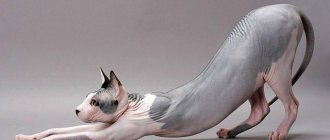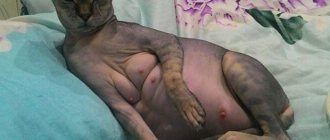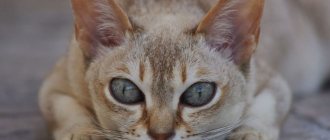Sphynxes are unusual cats that resemble aliens from another planet. Due to a genetic mutation and careful selection work, their body is completely or partially hairless. Because of this, representatives of the breed have a higher body temperature and require special conditions of detention.
Let's figure out how to care for the Sphynx in order to provide it with a comfortable and fulfilling life.
Preparing for the arrival of a kitten
In order for the process of weaning from its mother to take place without damage to the physical and psychological health of the little sphinx, it is taken to a new home no earlier than three months of age.
Representatives of this breed are usually reserved long before they are 12 weeks old. Therefore, happy owners have enough time to learn more about the features of caring for a kitten and prepare for its arrival.
To create decent living conditions for a hairless baby, they buy a “dowry” in advance:
- bowls for water, dry and wet food;
- carrying bag;
- tray with filler;
- scratching post;
- toys;
- grooming tools (nail clipper, toothbrush, etc.);
- hygiene products (ear cleaning lotion, toothpaste, etc.);
- bed or house.
In order to provide the little sphinx with not only proper care, but also safe living conditions, the apartment is also prepared for his arrival. Wires, indoor plants, household chemicals, fragile and small objects are hidden in advance from a curious and playful kitten.
On a note. When kept at home, inquisitive sphinxes try to explore every corner of their new property and often get into the most unexpected places like the oven or washing machine. To avoid tragedies, it is better to keep the doors of these devices closed, and before using the equipment, it is better to look inside once again to make sure that there is no little prankster in there.
Care instructions
When carrying out independent measures to care for a cystostomy, all procedures are carried out extremely carefully, avoiding sudden movements. It is important to follow all the rules, monitor the condition of the entire system and the hole in the area of the projection of the bladder. If any complaints arise (redness of the skin, discomfort), immediate monitoring by a doctor is needed.
The care procedure is carried out in compliance with sterile conditions; it begins with thorough hand washing with soap and warm water, preparation of all necessary instruments and materials, treatment of the skin adjacent to the stoma and the place where the tube is attached with antiseptic solutions. You will also need a basin to drain liquids after treatment and rinsing. The patient can sit or stand during treatment.
100 ml of saline solution is drawn into the syringe, injected into the drainage tube and then poured into the basin. Do this until the liquid is clear. For disinfection, use solutions selected by a doctor. To replace the cystostomy with a new one, it is recommended to call a doctor or nurse to your home.
Features of caring for the Sphinx
The exotic exterior cannot but affect the needs of the cat’s body. Therefore, it is better for potential owners to study in advance the features of care and maintenance of sphinxes.
Hairless cats have nuances with thermoregulation. Sphinxes do not tolerate dampness and drafts well. To protect representatives of the breed from hypothermia and colds, the room is maintained at a constant temperature within 20-25 °C. If this is not possible, the hairless cat is dressed up in a warm vest or blanket.
Sphynxes love warmth and love to bask in the sun. To prevent burns from leaving on the delicate skin, cats of this breed should not be exposed to ultraviolet rays for a long time.
Summer tan
Yes, yes - these cats can sunbathe, and even moreover, get sunburned. If a cat often spends time on a balcony or windowsill, then very soon its face, ears and back may begin to darken. With prolonged exposure to the sun, a cat can become severely sunburned, and the skin will begin to peel and peel, just like a human’s. Even being on the windowsill behind a closed window can cause the sphinx to darken, and this color lasts a very long time. A tan looks funny, but you still need to limit your cat's exposure to the open sun. Like people, Sphynx dogs can burn to the point of blistering, and burns can cause tumors.
What to do to avoid skin problems:
You can put sunscreen on your holopops, but only where he can't lick it off.
The second option is to dress up the cat a little. A summer T-shirt or dress will help protect the Sphynx's back, but the face will still be in the sun, so you still need to control that the cat does not lie in direct rays.
Cover the windows with mosquito nets - even such transparent protection will help the cat avoid severe burns.
Sphinxes simply love to lie in the sun, as they always lack warmth. Therefore, no matter what you do, the cat will still tend to the windowsill or balcony in the summer.
The right diet
In order for the Sphynx to develop well and remain healthy longer, it is provided not only with proper maintenance and care, but also with balanced feeding. To remain active and maintain body temperature, hairless cats require more high-calorie food than representatives of shaggy breeds.
On a note. If the Sphynx's diet is low in fat, the animal will become cold and begin to overeat to make up for the lack of energy. And this is fraught with digestive problems.
With the industrial type of feeding, high-calorie products of premium or super-premium class are purchased for sphinxes. Before making a choice, you need to carefully study the description of the composition and make sure that it has sufficient fat content and there are no questionable components.
The following criteria are met:
- Royal Canin;
- Acana;
- Grandorf.
With a natural diet, the Sphinx's menu is designed so that it contains at least 70% meat. Also included in the diet of cats of hairless breeds is:
- boiled offal;
- porridge with water;
- vegetables;
- eggs;
- dairy products;
- lean sea fish.
It is important to ensure that cats of this breed never eat bones, baked goods, sweets, smoked meats, pickles and sausages. Also, sphinxes should not be given mushrooms, onions, river fish, fresh milk and any leftovers from the master's table.
Description and breed standard
Descriptions of the Sphynx often include words such as graceful, strong, unique and graceful.
The Canadian Sphynx breed standards contain the following parameters:
- The head is medium-sized, elongated.
- The appearance of the muzzle is teardrop-shaped. The whisker pads are clearly defined.
- The mustache is very short or absent altogether.
- The Canadian's ears are large and wide, without hair.
- The eyes are large and shaped like lemons. Eye color comes in a variety of colors;
- The body is small with a wide chest. The muscles are well defined. The skin is very warm.
- The tail is long and whip-shaped. There is sometimes a small amount of fur at the end.
- The body is covered with folds.
The color characteristic is also included in the standard of this type of cat. The breed description allows for black, white, pink or bicolor cat skin color.
The character of the Canadian Sphynx
The peculiarity of the Canadian Sphynx breed is that they are very smart and easy to train. The cat quickly remembers its name, the location of the toilet and its beloved owner.
Unlike regular breeds, Sphynx cats get along well with other family members, animals and small children. Contrary to general belief, they are not aggressive and are not prone to sudden scratching and biting of fingers. Loving and sociable. The dear owner can be warmed for hours. You can leave a cat alone for 8–9 hours, but it will get bored.
Training and education
The affectionate and sociable nature of Sphynx cats, combined with high intelligence and good memory, make them ideal pets suitable for home keeping. A well-mannered cat will not damage furniture, ride on curtains or do other dirty tricks. Therefore, it is extremely important to have time to form the correct model of behavior in the kitten in the house.
On a note. You need to raise a Sphinx without using physical force. To stop unwanted actions or calm down an overly naughty kitten, you can lightly shout at it, splash water, or hiss threateningly.
Raising a Sphinx includes training in hygiene procedures. The kitten is taught to be calm about bathing, trimming nails, rubbing eyes, cleaning ears and teeth.
Toilet training
Even if the breeder’s kitten regularly went to the litter box, this does not mean that in the new home he will not recover anywhere. Therefore, to prevent the apartment from turning into a latrine for a cat, from the first moment the pet appears, you need to pay attention to its toilet training.
Typically, kittens defecate after sleeping or eating. Noticing that the baby is about to go to the toilet, he is carefully picked up under the stomach and taken to the tray. As soon as he does his job, he will definitely be praised.
On a note. If the kitten went to the toilet in the wrong place, the puddle is blotted with a napkin, which is then placed in the tray. And the “crime scene” itself is wiped with water flavored with a small amount of citrus juice.
Health and diseases
Experts do not classify the Sphynx breed as an animal with poor health. The immunity of born kittens is normal; the Sphynx rarely coughs, but like the entire cat family, they can be susceptible to viral and bacterial infections.
The peculiarities of the breed are caused by the fact that Sphynxes were bred by breeders artificially through inbreeding in order to achieve a unique mutation with smooth, rubber-like, hairless skin with many folds. As a result, a unique breed was developed, but prone to genetic abnormalities that lead to sphinx disease and abnormalities in the development of organs: eyes, skin, mouth and spine.
The main diseases of sphinxes and pathologies:
- skin diseases, fatty sweating caused by bare skin, almost without hair;
- eye diseases and eye abnormalities, the cause is the absence of eyelashes;
- shortened lower jaw in the oral cavity or “carp bite”;
- underdevelopment of the thoracic and lumbar vertebrae, a common congenital disease;
- reduced growth as a consequence of serious defects.
My eyes are watering
Newborn kittens are predisposed to eye diseases caused by inflammatory processes of the cornea, causing conjunctivitis and scleritis. Eyes that are not protected by eyelashes, and sphinxes simply do not have them, are injured, and debris, dust, and dirt get under the eyelids, which cause inflammatory processes:
- Catarrhal conjunctivitis manifests itself as clear discharge in the form of lacrimation. The membranes of the eyes are marked by redness and swelling, the animal feels pain.
- Infectious purulent conjunctivitis with characteristic gray-green discharge.
From birth, kittens' eyes are given special attention, daily examinations are carried out, and they are washed with furatsilin. Specks are removed from under the eyelids and mucus is removed. Do not allow your eyes to water too much.
Attention! If purulent or infectious discharge appears, self-medication is not allowed; you must consult a veterinarian for advice.
Entropion of the eyelids
The most common pathology is entropion of the eyelids in the Sphynx, which manifests itself in kittens from birth. The disease is determined externally; the eyelid bends inwards, which is very disturbing for children; they suffer from continuous conjunctivitis, discharge in the form of tears and possible infectious purulent discharge. The only way to help kittens get rid of entropion is through surgery.
Attention! Surgical interventions are corrective in nature, which does not completely eliminate the pathology, but leads to some improvements.
Lichen
Kittens with weak immune systems and adults are more often at risk when lichen occurs in the Sphynx when interacting with sick animals or when being in an infected environment. <Dermatophyte> (lichen) is a fungal skin disease that is seasonal and often occurs in cats after estrus. It manifests itself in the form of inflamed, shabby lesions, eczematous areas in which the skin itches and peels.
Attention! Ringworm is a serious, contagious disease that will not cure itself. When the first signs appear, treatment is prescribed by a veterinarian.
When a pet is diagnosed with lichen, the doctor prescribes long-term treatment with medications and treatment with antimicrobial agents, with mandatory compliance with all procedures. Infection with lichen can be prevented by timely vaccinations against all infectious diseases, which are given on schedule.
Skin rash
A rash on the skin of the Sphynx can appear in both male and female cats at any age, completely devoid of “rubber” fur. Rashes occur during active puberty, caused by hormonal secretion of sebum.
Acne (acne) due to the hereditary predisposition of the breed is observed:
- on the back along the spine;
- on the face;
- on the surface of the abdomen;
- under the jaw with the neck;
- in the form of black dots on the tail.
Infection of the skin with acne spreads throughout the body of sphinxes with a certain color. Mostly blue, blue-cream and red animals that are completely naked without hair are susceptible to acne. In flocked plants, rash is less common.
For treatment at home, gels and solutions such as “Zinerit”, “Minocycline”, or “Lindamycin” are used. For mild forms of spread, rubbing with salicylic acid and hydrogen peroxide helps. For severe forms of the rash, consult a veterinarian.
Inflammation of the rash as a result of bacterial activity develops both on the surface of the skin and deep in the subcutaneous layer. There are 2 types of acne:
- Comedones on the surface of the skin with a mild inflammatory process.
- Ulovatocystic acne with deep formation of purulent cystic cavities, manifesting itself in the form of fistulas with the formation of scars.
Advice! Avoid keeping your pet in the sun for a long time.
Dermatitis
When the owner adheres to keeping the pet only at home, then dermatitis in the Sphynx has little risk of being detected on the skin. It is possible to become infected with a similar skin disease by bringing secondary infections into the home.
Dermatitis, when it is impossible for cats to scratch the sore spot, may spontaneously disappear without the use of medicinal drugs. In severe cases, it is enough to use Dexafortor, a single infection or Terramycin spray.
Hygiene
To ensure that the Sphynx always has a neat and aesthetic appearance, he is provided with regular care, which includes a whole range of hygiene procedures.
Bathing kittens and adult cats
Despite the lack of hair, Sphynx cats need regular washing. Therefore, bathing procedures should become an integral part of caring for these animals.
Sphynxes are bathed once a month using baby gels or special shampoos for hairless breeds.
Important! Sphynx cats should not be dried with a hairdryer so that the hot air does not burn the skin. Therefore, after bathing, cats of this breed are dried with a towel and lubricated with baby cream.
Skin care
Sphynx cats have no hair, and their sebaceous glands produce a lot of secretion, which accumulates and turns into a brown crust. It not only makes cats look unsightly, but also causes discomfort. If left untreated, over time, the skin underneath begins to itch and emit an unpleasant odor. As a result, a cat of this breed develops inflammation and dermatitis.
Therefore, an important aspect of Sphynx care is regular cleansing of the skin. The body of a hairless cat is systematically wiped with special wipes or a moistened cloth, paying special attention to the folds.
Important! Improper or irregular care of the Sphynx leads to the formation of black spots on the cat's skin. The comedones are carefully squeezed out, and the affected area is treated with an antiseptic.
Eyes
Since Sphynx cats do not have eyelashes, they are prone to eye diseases. Grooming for the breed should include regular eye examinations.
In healthy cats, clear or brown discharge accumulates in the corners. Therefore, the eyes of the sphinx should be wiped daily with a cotton swab dipped in boiled water or chamomile decoction.
Important! If yellow or green discharge appears in the eyes, it is advisable to show the cat to a veterinarian.
Teeth
Caring for a Sphynx cat includes cleaning its fangs and incisors. This procedure is carried out at least 2-3 times a month using a non-foaming paste applied to a silicone brush or a special attachment.
Systematic care of your cat's teeth will help get rid of plaque, help strengthen the gums and serve as a preventive measure against the formation of stones.
Ears
Hair cats grow in their ears, which prevents the penetration of dust and dirt. Hairless Sphynxes have unprotected ears. Therefore, even with strictly residential care, caring for cats of this breed involves mandatory cleaning of the ear canal.
The ears of sphinxes are regularly wiped with a clean cloth soaked in a special lotion or Vaseline oil.
Claws
To ensure that a cat living at home does not damage furniture and walls, caring for it should include regular trimming of its claws. The procedure is carried out using a nail clipper very carefully so as not to injure living tissues or cause pain to the cat. If representatives of the breed do not have their claws shortened, then a considerable amount of money for repairs and renovation of furniture can be added to the cost of keeping the cat.
Bathing sphinxes
Special attention should be paid to your pet’s water procedures. Sphynxes have increased heat exchange processes - they sweat a lot.
To make your pet feel comfortable, you need to regularly bathe your Sphynx in warm water using special shampoos. Alternatively, use a mild baby shampoo.
Such procedures must be performed at least 2 times a week. The rest of the time, you can wipe your pet's skin with wet wipes.
Be careful not to get any water into your Sphynx's ears or eyes while bathing.
Vaccination
Sphynxes kept at home run the risk of becoming victims of viral and infectious diseases no less than their street counterparts. To protect cats of this breed from dangerous diseases, their care should include routine vaccination.
They are regularly vaccinated with a complex drug that stimulates the development of immunity to panleukopenia, calcivirosis and rhinotracheitis.
This is done for the first time when the kitten is 7-8 weeks old. After 4 weeks, the sphinx is revaccinated against the same diseases and against rabies. In the future, the cat is vaccinated annually, regardless of whether it is exclusively kept in an apartment or is on the street.
Important! Before vaccination, the animal must be subjected to antiparasitic treatment. Anthelmintic drugs are given to the cat 2 times with an interval of 10-14 days. The dose is calculated based on the pet's weight.
How to breed Sphynx cats
The Sphynx cat breed becomes ready to breed at the age of one and a half years. The first estrus occurs at the age of 5–12 months. However, estrus at an early age does not mean that the girl is ready for mating. It is best to wait until 1.5–2 years. Only in this case will the offspring be strong, and the mother cat’s health will not suffer.
The girl is brought into the cat's territory.
How is pregnancy progressing?
Pregnancy and childbirth, as a rule, proceed without complications. Gestation time for kittens is 63 weeks. A pregnant woman must be surrounded with care, affection and well fed. At one time, a cat brings from 1 to 12 kittens. Newborn kittens of this breed open their eyes early, so their condition must be monitored.
Castration and sterilization
Mature cats very actively mark their territory, which is accompanied by an odor that is not pleasant to humans. Girls' heat is also quite active, with loud meowing and rolling on the floor. If breeding is not planned, it is better to castrate or sterilize the animal. The optimal age for the procedure is 8–10 months.
HISTORY OF THE BREED
Cats without hair (“hairless” cats) have been born around the world many times throughout history, but no one has ever thought of breeding them in this form, much less classifying them as a separate breed. Everything changed quite recently - in 1966. And this happened in Canada (Ontario), when one hairless cat gave birth to the same “naked” kitten named Prune. Canadian breeders immediately decided to consolidate this success and began to cross Prune with their own mother and their own daughters.
For a long time, nothing good came out of this - the mortality rate of the resulting kittens was very high. But the situation was saved by two more hairless cats born in the USA and Canada. They became the founders of the new breed, but it is worth noting that they were additionally crossed with cats from the Devon Rex breed, which were similar in appearance to the future Canadian Sphynxes.
Reviews about the breed
Dmitry Utiugov, 35 years old, Simferopol
I used to have a negative attitude towards cats that don't have fur. We got our Sphynx named Jerry with my wife when she was pregnant with her second child. After that, my attitude towards hairless cat breeds changed dramatically. These are extremely affectionate and friendly pets that do not leave behind any fur and get along well with children and their owners.
Irina Bulgakova, 39 years old, Moscow
I bought my girl Musya from a nursery. I decided to choose a hairless cat, because... I am allergic to cat fur. Now Canadians are my favorite breed.
How to choose a kitten
The main advice is the same for all purebred animals: do not try to save money on your purchase by going to the “bird market” or responding to a random ad. Only the best nurseries and breeders with an impeccable reputation will guarantee that you will receive a healthy pet, the origin of which cannot be doubted. After all, the Canadian Sphynx is not just a lack of hair, but a graceful, beautifully built, affectionate and intelligent creature that will live next to you for the next few years.
If you do not plan to participate in exhibitions, it is enough to make sure that the chosen baby is healthy and active, easily makes contact with people, without showing fear or aggression. The rest will be determined by the available documents (pedigree, veterinarian’s report, vaccination card). We recommend getting to know the parents and looking at the living conditions - they will say a lot about the breeder’s attitude towards the cats.











